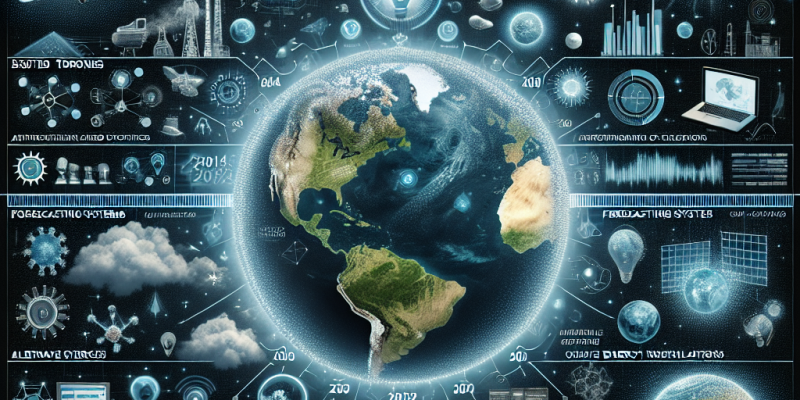2024 and Beyond: The Impact of AI on Climate Change Solutions

As we usher in 2024, the conversation surrounding climate change has never been more urgent. With the repercussions of global warming becoming increasingly apparent, nations, businesses, and communities are ramping up their efforts to address this existential threat. Among the myriad tools at our disposal, artificial intelligence (AI) is emerging as a pivotal player in developing innovative climate change solutions. This article explores the role of AI in combating climate challenges, examining its potential, pitfalls, and future contributions.
The Promise of AI in Climate Solutions
1. Predictive Analytics and Climate Modeling
AI’s capability to process vast amounts of data and recognize patterns makes it invaluable for climate modeling and prediction. Advanced algorithms can analyze historical climate data alongside current variables to forecast future climate conditions, extreme weather events, and natural disasters with greater accuracy. This predictive capability not only helps governments and organizations prepare for adverse events but also guides long-term planning and policy-making.
2. Enhancing Energy Efficiency
In the energy sector, AI is innovating the way we generate, distribute, and consume energy. Machine learning algorithms analyze user behavior and energy consumption patterns, facilitating smarter energy use and reducing waste. For instance, AI can optimize energy consumption in smart grids, making real-time adjustments based on demand and supply. Furthermore, predictive maintenance of energy infrastructure helps reduce downtime and maintain efficiency, ultimately lowering greenhouse gas emissions.
3. Sustainable Agriculture Practices
Agriculture is a significant contributor to climate change, but AI is helping to create sustainable practices that can mitigate this impact. Machine learning tools are being used to analyze soil health, weather patterns, and crop yields, enabling farmers to make data-driven decisions. Drones equipped with AI are being deployed to monitor crops and assess their health, allowing for targeted interventions that improve yields while minimizing resource use. As a result, AI can help create a more resilient agricultural sector that adapts to the changing climate.
4. Carbon Capture and Management
AI is playing a critical role in the development and optimization of carbon capture and storage (CCS) technologies. By analyzing geological data and simulating potential storage sites, AI can improve the efficacy of CCS strategies, ensuring that carbon dioxide is securely captured and stored underground. Moreover, AI models can optimize the operational processes of carbon capture facilities to maximize their efficiency and reduce costs.
5. Transportation and Mobility Solutions
Transportation is a major contributor to greenhouse gas emissions, but AI has the potential to revolutionize this sector. From autonomous vehicles to smart traffic management systems, AI is enabling more efficient transportation networks. Machine learning algorithms help optimize routes, reduce congestion, and minimize fuel consumption, all of which contribute to lower emissions. Additionally, AI-driven public transit solutions can enhance accessibility, encouraging more people to opt for sustainable modes of transport.
Challenges and Ethical Considerations
While the potential of AI to address climate change is immense, several challenges and ethical considerations must be addressed to ensure its responsible deployment. One major concern is the energy consumption of AI systems themselves. Training complex algorithms often requires significant computational power, potentially negating the environmental benefits they are designed to achieve.
Another critical issue is equity. The implementation of AI technologies may inadvertently exacerbate existing inequalities if access to AI solutions is uneven across different regions or socio-economic groups. Policymakers must ensure that the benefits of AI for climate action are distributed equitably, particularly in vulnerable communities that are most affected by climate change.
Additionally, the reliance on AI should not overshadow the importance of traditional ecological knowledge and community-driven solutions. Collaborations between technology experts and local communities can foster a more holistic approach to climate action.
The Road Ahead
As we move further into 2024 and beyond, the integration of AI into climate change solutions will likely deepen. Global summits, research collaborations, and public-private partnerships are increasingly prioritizing the exploration of AI-driven technologies in the fight against climate change. Investment in AI research and development will be critical to innovate and refine these solutions.
Moreover, ongoing regulatory frameworks and ethical guidelines will be essential to guide the responsible use of AI in climate initiatives. As governments and organizations shape policies to harness AI’s potential, they must consider environmental sustainability, social equity, and long-term impact.
In conclusion, artificial intelligence stands at the forefront of climate change solutions, offering tools and insights that can drive meaningful action. By addressing the challenges and working collaboratively across sectors, we can unlock AI’s full potential to combat climate change and build a more resilient and sustainable future. The time is now to embrace this technology, not just as a tool for innovation, but as a partner in the global effort to avert the climate crisis.














